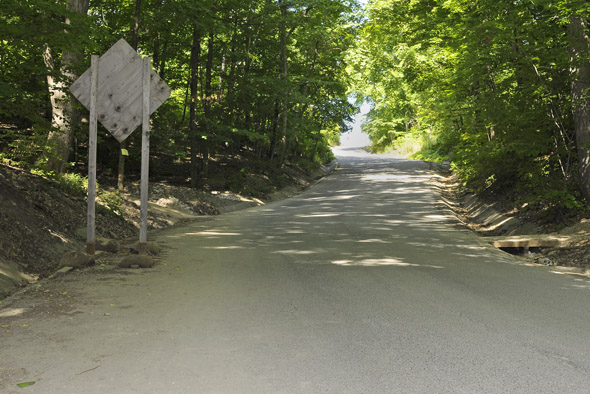
"Hidden" streets in Toronto
While there aren't really completely hidden streets in Toronto -- hence the use of scare quotes in the title -- a small collection of laneways, cul-de-sacs and service roads do exist as mostly uncovered gems in the city's vast street scape. And having explored the city by bike for many years, I've been fortunate enough to encounter a number of them (though I'm sure there are more) during my rides.
Many of these streets are dead ends that offer little reason to walk, ride or drive though aside from the satisfaction of curiosity. But for those interested in old architecture or just places that aren't heavily trafficked, they can be fascinating to visit. Of those that I've stumbled upon, there are some particularly excellent examples of 19th century housing, which has somehow managed to escape modern redevelopment. Indeed, if one squints his eyes on a few of these streets, it's almost possible to imagine what the city must have looked like a century ago.
Here's a short list of some of my favourites with (when available) an embedded Google Streetview map, which should allow for a little virtual exploration.
Wellesley Cottages
Located just to the east of Wellesley and Parliament, Wellesley Cottages is actually the name of this street as well as a description of the small houses that exist here. Built for labourers in the late 1880s, it's remarkable how little this area resembles the rest of the city. With the narrow laneway entrance to the enclave, I'm almost surprised that the Google car even entered this area. But, I'm glad that it did, because it's pretty cool to show off this unique Toronto street to those who haven't seen it before.
Alpha Avenue Cottages
Alpha Avenue is located just around the corner from Wellesley Cottages, and while not as quaint, it still offers a lovely example of 19th century Toronto architecture. And, hey, if you're going to explore one, it only makes sense to check out the other. To some extent, my favourite part of this street is the obvious dichotomy with the concrete apartment structures of St. James Town to the west.
Ashby Place
Located on the eastern edge of Corktown, at first glance, Ashby Place looks almost identical to Alpha Avenue. A colourful little throwback to time when Toronto streets were far more dense than they are today, there are, however, subtle differences that set them apart. But it's still fascinating to witness two little pockets of history that have been preserved so well.
Draper Street
Just to the west of the Globe and Mail building, Draper Street is the subject of an in-depth historical study conducted by Heritage Toronto. I can't possibly summarize all the information on offer in the study, but the skinny is that the land around the street was purchased by William Henry Draper (who later went on to become the Chief Justice of Upper Canada) in the 1830s, and the street was developed between 1881 and 1889. Despite the overlapping time period, it's fun to note the differences between the houses on Alpha and and Ashby and those on the west side of the city here at Draper.
Beechwood Drive
One way in and out of the trail system that lines the Don River, Beechwood Drive is easy to spot off O'Connor Drive. But as one follows it towards the DVP, it draws a 180 degree curve underneath the parkway and dead-ends. Well, for cars at least. This is one fun road to ride a bike down (if not up!), and actually continues all the way down into the valley below.
Redway Road

Almost directly opposite Beechwood Drive on the other side of the valley is Redway Road, the first part of which is quite visible due the presence of a Loblaws location there. But before the grocery store, the street was used primarily for service vehicles to access the North Toronto Wastewater Treatment plant, which is a vaguely horrifying camp-like property at the bottom the steep hill down into the valley. Given the plant and the fences that surround it, it's hard not to feel like you're somewhere you shouldn't be when you travel down Redway. But that only adds to the intrigue of exploring it.
Croft Street
Perhaps the best known of the streets on this list, Croft Street is one of the only places in the city where laneway housing exists in reasonable supply. As such, Croft offers a glimpse into what Toronto's many back lanes might look like if there weren't so many obstacles surrounding the process of getting such structures built. A mix of garages, some adorned with graffiti, and variations on coach houses, the laneway/street (it does feature official speed limit signs) is best explored on foot, so as to be able to appreciate fully the urban strata on display.
Lead photo of Wellesley Cottages by alisonh29.
Latest Videos
Latest Videos
Join the conversation Load comments







